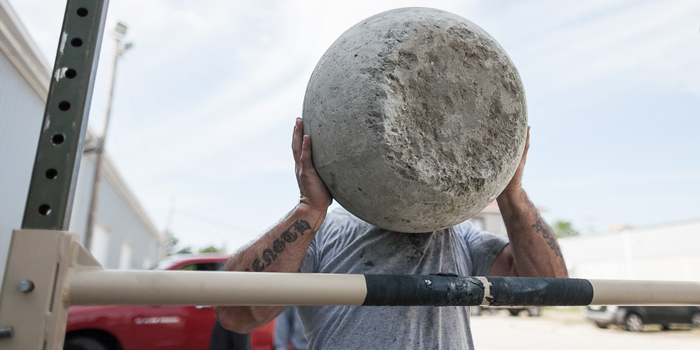
Let me start by prefacing this with an opinion stated as though it was fact. Jim Wendler is two things: cool as fuck and switched on when it comes to training. Okay, the latter can probably be proven as fact. If you're reading this and you've not at least read Jim's first edition of 5/3/1, then go away and pay some respect. Then come back and watch me bastardize the fuck out of the system.
If you have time between complaining you don't have time to train and watching the latest Netflix craze, you should also Google "Jim Wendler articles" and immerse yourself. I have a personal soft spot (or hard spot) for the "Blood and Chalk" Q&A series. Hilarious and informative. This may sound like I'm on payroll for www.jimsboys.com or just trying to get free stuff, but the simple, focused, no-bullshit approach of Jim Wendler and his 5/3/1 program holds a huge appeal to me. I'm simple too, you see.
RELATED: Developing Your Strongman Program
However, I myself love the sport of strongman. I compete and do well. Do not get me wrong, I'm not winning WSM next year, but neither are 99.9% of us. I have high aspirations for myself in the sport, and I hope that even if you don't want to compete, you at least expect a high standard of your physical self.
Most of us who participate in strongman at whatever level want to be strong as fuck! To push trucks, lift cars, pull women, and manhandle stones heavy enough to be our metaphorical bollocks. A very large portion of us doesn't care if we ever get to Worlds or the Internationals. Most of us would be happy with a solid deadlift, some cool scars, and the average gym-goer asking us how much test we use. Throw in a few Instagram shots of us holding up a Vauxhall, and we'd be happy.
Why I Wrote This Program
I like writing shit down. I figured I could at least write something useful! I've run 5/3/1 myself, and I love the program (I may have mentioned that already). So I went to my beloved Google and asked for "5/3/1 for Strongman" and I was surprised to see that there wasn't a whole lot out there. So I've decided to share what has worked for me and clients, athletes, and friends of mine who were trying to get stronger and do some cool shit along the way.
One of my biggest peeves with the fitness industry and even more so in the strength world is people avoid doing the basic, obvious training in favor of overly complex programs that beat around the bush and never go for the fucking kill. Earlier today, I was chatting with a guy about passing his military fitness test (a mile and a half run). I asked how much running he's been doing, and his answer did not surprise me.
"None. I've been riding the exercise bike."
My response of, "I'd start fucking running now if I were you," was both meant as literal advice and a genuine threat because of the instant rage I felt at the stupidity of the answer. I'm not saying that riding the bike couldn't help raise your lung capacity for cardiovascular endurance or help you with learning to tolerate any lactic acid build-up you might get in the legs while running. What I am saying is that if you are being tested on your ability to run a mile and half, why the fuck are you not running a mile a half at least once a week just to get some kind of indicator?
I digress. Specificity, or at least training for a goal matters. If you want to do strongman, then the clue is in the name. "Strong" means get strong. This program has been written to get you strong in the right way for the sport. It's a great sport, and it's a great way to train for anyone looking to get strong and fit in a measurable way.
5/3/1 Philosophies
- Start too light and progress slowly
- Break PR’s
- Emphasize compound movements
Honestly, I shouldn't need to parrot this stuff, but I have a feeling that it often gets overlooked.
5/3/1 Basic Structure and the Training Max
The percentages for the core lifts of 5/3/1 are worked out from your training max (TM). Your TM is 90% of your true one-rep max.
To begin, test your actual one-rep max. Do not look at your notes from three years ago, when you were on gear and training every spare minute you had, but now you're just getting back into training. "I used to be able to..." usually translates to "I don't stand a fucking chance of…" It only takes a week or two to do some tests, so your numbers are up to date. Do it.
For example, if I can overhead press 100 kilograms, I simply grab a calculator and type in 100 x 0.9. The answer is 90. So that makes my TM 90 kilograms. All my programmed percentages are from 90 kilograms. It's not rocket science. It's basic mathematics.
So how does this translate to the workouts? Well, in every session there are three working sets. The reps are set and the percentages are marked out for you. Where you see a set with a "+" sign, it means dig deep and do more if you can. I like to set a target for this last set before I'm under the bar. Pick a number you want. Focus, take a breath and go to war for it.
Week 1:
- Set 1: 5 x 65% of training max
- Set 2: 5 x 75% of training max
- Set 3: 5(+) x 85% of training max
Week 2:
- Set 1: 3 x 70% of training max
- Set 2: 3 x 80% of training max
- Set 3: 3(+) x 90% of training max
Week 3:
- Set 1: 5 x 75% of training max
- Set 2: 3 x 85% of training max
- Set 3: 1(+) x 95% of training max
Week 4 — Deload (not shown in the tables):
- Set 1: 5 x 60% of training max
- Set 2: 5 x 60% of training max
- Set 3: 5 x 60% of training max
Some people don't use a forced deload and go by feel. This is fine if you can actually judge it with some degree of accuracy. I would really suggest taking one if you run two cycles back to back. This is heavy, hard work.
After each cycle, you add weight to your lifts and repeat. Add five kilograms for lower body lifts (squat and deadlift) and two and a half kilograms for upper body (overhead press and cleans).
So What’s Different?
"Well, this is all well and good," I hear you say. "But I've seen this all before. What are the differences that adapt this already fabulous system to strongman training?"
Fair question. There are a few tweaks I've made to the program to help adapt it to strongman training. The two most notable are exercise selection for the core lifts and timed AMRAP (as many reps as possible) sets.
Exercise Selection
The barbell bench press is out. I'm not saying it doesn't have a place in training, and I'm sure you guys who can't be without will work it in there somewhere. But we are focusing on the overhead press and the ability to clean that weight into the pressing position. So many strongmen press from the rack only to find out they can't clean the weight up on contest day. Duh.
Also, I've gone with front squat over traditional squat for a couple of reasons. It has a huge crossover to strongman events having the weight out in front of your body rather than over your shoulders. In an ideal world, you'll get under a yoke most Saturdays too. That's a lot of heavy spinal loading to have alongside squats. However, if you can handle it and your shoulders have the mobility to squat without irritating your elbows, then feel free. The SS Yoke Bar is also a great variation.
So your core lifts are now:
- Overhead Press
- Front Squat
- Barbell Clean
- Deadlift
Timed AMRAP Sets
Max reps in an allotted time appear in every single contest. It is far more common than max weight in strongman. It's usually 70 seconds, and it fucking sucks. So I'm doing you a favor and getting you ready for it!
You'll see a bold "Set 4: 60 seconds AMRAP @ *given %*" in the program below. Depending on whether you're on a three-day or four-day per week template, it occurs at different times. It is a variation on the First Set Last principle that Jim Wendler talks about in some of the later editions of 5/3/1.
Don't puss out. I'm not saying it needs to be for all the big movements in every three-week cycle. In fact, I've only given you two sets per three-week cycle. So sack up and get involved.
Templates
Who doesn't like to train every single day? Well, most people. And we all know that recovery is important, even if some of us are guilty of ignoring it. So I've stuck with two simple templates based on a normal working week. My suggestion is that if you run the three-day template, you take one day off between each day and then two days off after the events.
With the four-day template, I would do the press and deadlift days consecutively, then take a day off before the squats and cleans, and then another rest between that and the events day. I'll put hypothetical days in brackets to help.
Three-Day Template
- Press and Squat (Monday)
- Deadlift and Cleans (Wednesday)
- Events (Friday)
Four-Day Template
- Press (Monday)
- Deadlift and Carry (Tuesday)
- Squat and Cleans (Thursday)
- Events (Saturday)
Easy peasy! If you are busting ass in these workouts you won't need to keep adding extra workouts. Don't get me wrong, I enjoy getting an extra day to build up my girly calves as much as the next man in denial that they're "fine", and if you have the time and the recovery ability to do more, then fantastic. But don't bitch and moan when you add extra days to pull heavy deadlifts and carry a heavy yoke and then are fucked after just eight weeks.
This is not an eight-week endeavor. Getting strong takes years and years of constant work, patience, and overcoming obstacles. It's like trying to pull a nine when your ugly mug is only a five, and you don't have money. It's not impossible, and sure, you may have to watch a few other people get to pull it before you. But consistency always pays off. Do you want a quick fix for being strong? That's like ordering your significant other over the phone and expecting for the fairy tale ending: you are going to get fucked, just not the way you hoped.
Three-Day Template — Day 1, Press and Front Squat
Three-Day Template — Day 2, Clean and Deadlift
Three-Day Template — Day 3, Events
Pay attention. It gets different here!
Four-Day Template — Day 1, Overhead Press
Four-Day Template — Day 2, Deadlift and Carry
Four-Day Template — Day 3, Cleans and Squats
Four-Day Template — Day 4, Events
Pay attention. It gets different here!
Contest Preparation
If you decide to take the plunge and compete at a show, you will not regret it. It's fun, it's challenging, and it's a celebration of all the work you put in. No one will judge you if you're not destroying every event—and if they do, then fuck that person. Do your prep. Practice the events. Turn up and test yourself.
There are some adaptions I like to make to the training cycles, and the adaptions are largely based on the events you will have. Usually, you will know well in advance what the events will be. So take time to prep. I would look at a three-cycle prep personally, which is 12 weeks. Of course, you could do it in less. Strong is strong, and as long as you are confident in your ability to complete the events, one cycle would be fine, and two would be plenty. I like the 12 weeks to get a ton of practice and iron out any weaknesses that may cost me points on the day.
Prep Structure
For prep, I change to a slightly different structure and start using 3/5/1 Deload. During this week of five-plus, you will not go for max reps. Just do the five required. Think of it as a medium effort week between two heavy weeks of three-plus and one-plus, both of which will have First Set Last protocols in place.
- Week 1: 3's — Heavy
- Week 2: 5’s — Medium
- Week 3: 1’s — Heavy
- Week 4: Deload — Light
General Tips
Be smart with your training max.
I would test the event if you can. If it's a floor to overhead log press with 100 kilograms for time and you can already do 120 kilograms for one rep, great. Use the normal formula to work out your TM and work to your ability.
If the event is way too heavy for you to complete at your current strength, then take a look at whether you want to turn up and zero rep a contest and feel like shit after (because you will). No one will judge you if you aren't winning, but people may question what you were doing if you look like you're going to break every time you attempt a rep.
Adjust your last set.
If the event is a timed event, it might be wise to practice working to time. Again, use your judgment. If you know that you can do three reps at the given weight, then great. Work on increasing reps with that weight using the traditional 5/3/1 approach. But then use the First Set Last principle and do a timed set. Load the weight from the first working set from that movement and set your stopwatch to "holy shit."
Lower your assistance work.
All that shit after the main lifts is great, but it's pointless if you can't recover session to session and do each event with maximal effort. Tone it down or drop it completely. Just do what you need to stay balanced and injury-free.
Changes to the Actual Training
Press Event
You are bound to have one in your competition: log, axle, keg, monster dumbbell, medley. Switch out your 5/3/1 overhead barbell press for whatever implement is used in the event on your primary lift. Also, check if it's one clean then press from shoulder or if every rep is from the ground.
Deadlift Event
You see these a lot. It's usually event three or four to really fuck with everyone before the end of the show. Do your research. Is it max effort? Is it round robin? Is it for reps? Timed? Straps allowed? Suits allowed? Axle? Barbell? Side handles? What height will they be set to?
Atlas Stones or Static Load (No Shuttle Running)
Replace front squats with the event. Done.
Carry Events
These come in all shapes and sizes. Yoke and farmers are probably the most notable, but cars, sandbags, stones, kegs, and even people have been used. I've seen it all. Sometimes it's a straight run. Sometimes there's a turn. Sometimes it's a medley. Whichever you're doing—and often a show will have two of these—practice as close to the event as you can!
Vehicle Pull
This is usually one of two variations: in a harness pulling the vehicle behind you like a fucking workhorse or with a thick rope in hands, pulling the vehicle towards you hand-over-hand. If you have one of these, do your best to emulate the event. Buy some rope and borrow a friend's 4x4.
Miscellaneous
Keg toss, tug of war, pole push, log toss, and timed holds could also be in the competition. There's no end to the fun! Just remember to practice the event as best you can with what you have available. Use your imagination and Google.
So let's look at a 12-week prep cycle, shall we? Let's say we are looking at the cornerstone events.
- Log Press: Floor to overhead every rep, 70 seconds
- Farmers Walk: 40-meter total with one drop and turn at 20-meter mark
- Deadlift: For reps, 70 seconds
- Super Yoke: 20-meter straight run
- Atlas Stones: Five stones of ascending weights loaded to platform
For the sake of argument, let's say you can complete five reps with the given weights for the static events. You've managed the weight and distance on the farmers walks in training, but you're no Speedy Gonzales. And you can complete the fifth stone in the series if it was a PR effort on a kick-ass day after a caffeine IV.
So you've chosen to set your training maxes to your own true 2RM on the log and deadlift. You've set the TM for the walking events at the weight they will be on the day. The stones you're going to use the next weight down from the top contest weight that you have available until it's time to test a single.
After this, do your deload week. Here I would probably go back to the barbell lifts to aid recovery. Add the necessary numbers to your core lifts as you would with the normal 5/3/1 cycle and go again. With some implements, adding the correct weight can be difficult. Atlas stones don't tend to come in five-kilogram increments. This is fine. Either keep the weight the same and fight for more reps or increase the weight and try not to drop too many reps. You'll do more weight and more reps in an ideal world, but let's remember the core values. Progress slowly!
Common Questions and Shit I May Have Missed
Questions? Yes, you, with the piss-wet pants.
“But Aaron. I don't have any access to the specialized kit. What am I to do?”
Sigh. Alright. I get that this is a common problem. Let me say if you're looking to do a competition, find a gym you can travel to at least once every couple of weeks during your prep time that at least has some of the equipment you need.
Dumbbell farmers walks are fine, but it's not like the torpedo they make you run around with on contest day. There is a crossover, but why leave it to chance? A lot can be done with a set of Fat Gripz, your own stretch bands to tie weight plates together to emulate stones or shields, and a beer keg (filled with water or sand) or sandbag in your garden shed. Invest a little. It's worth it. Skip the next work curry night if money is tight. Fuck those guys. They don't help you lift cool shit.
“I can only afford one pair of shoes. What’s the best all round strongman shoe?”
Adidas Samba. Next.
“I’ve seen a lot of strongmen strapped up like they’re the Stay Puff Marshmallow Man on roids. Do I need straps, sleeves, wraps, belts, etc.?”
Short answer, yes. But I competed my first 18 months without any assistive gear except straps for deadlift for reps, and I managed to win Britain's Strongest Novice athlete at BodyPower UK. So you don't need it all in the beginning. However, as the weights get bigger and bigger, it definitely becomes useful and safer to kit up—not for every single set and rep, but on your working sets it definitely doesn't hurt.
“Nutrition?”
Hahaha. I like pizza. Look, eat for your goal like you train for your goal: good meats, tasty carbs, and Budweiser on a Friday.
Aaron is a competitive u105kgs strongman based out of Hereford, England. During his first year competing, he won BodyPower UK's Strongest Novice and, in his second year, qualified for England's Strongest Man u105kgs.









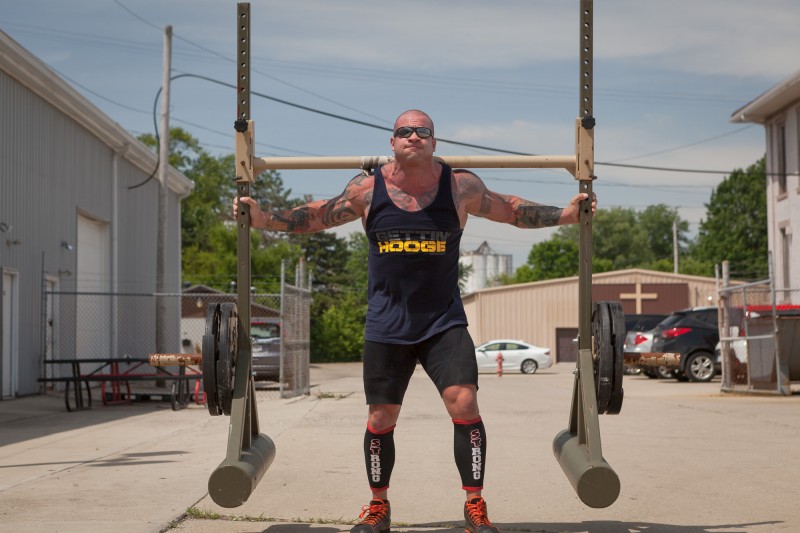
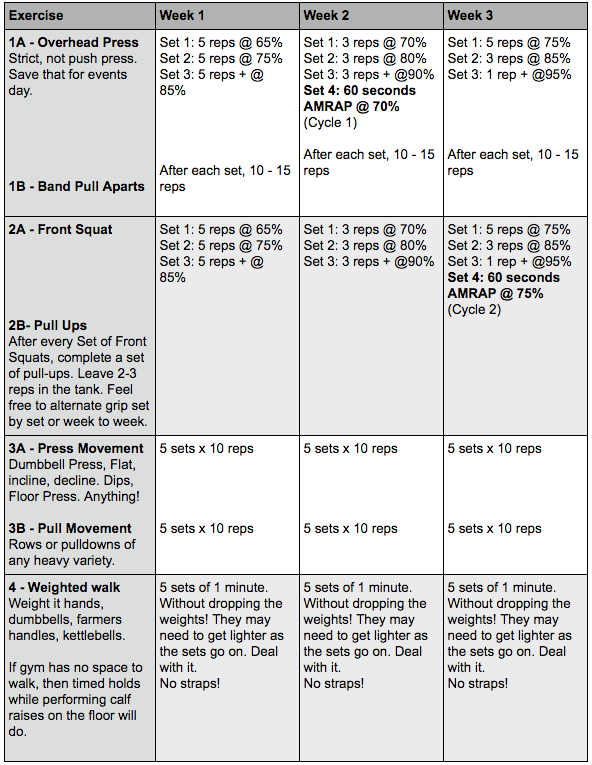
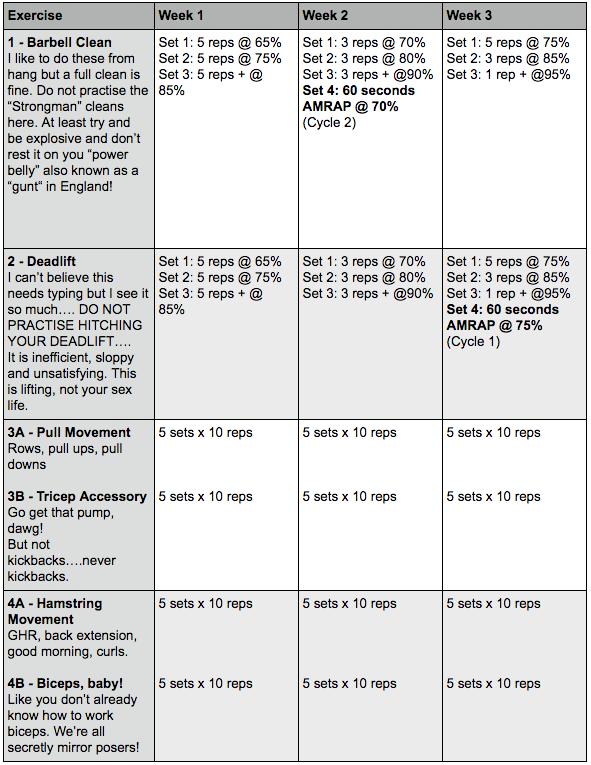
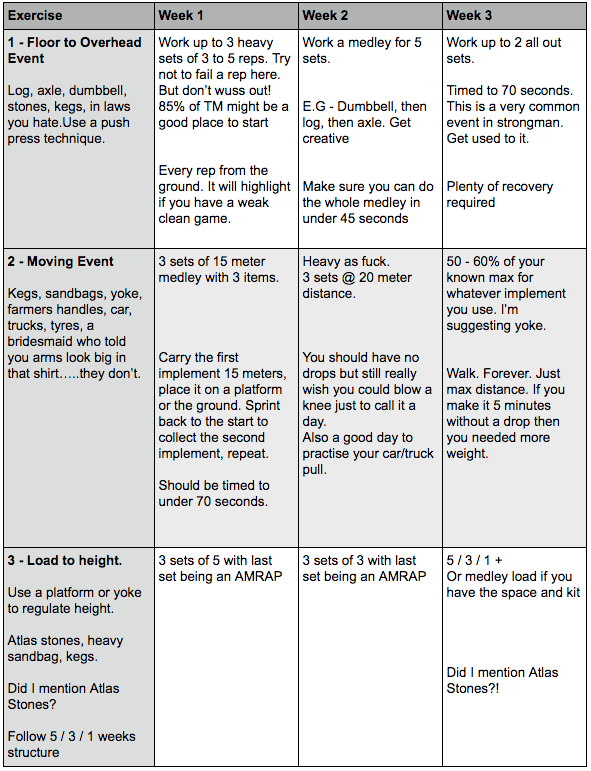
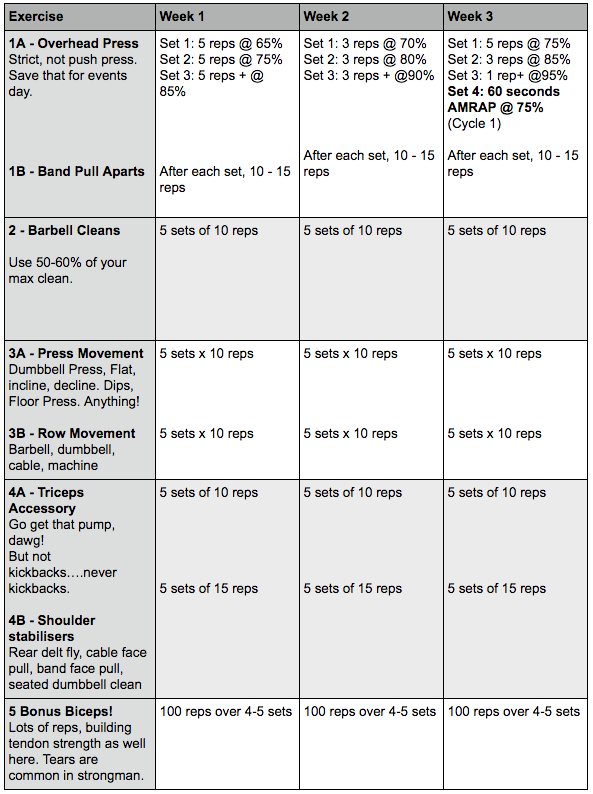
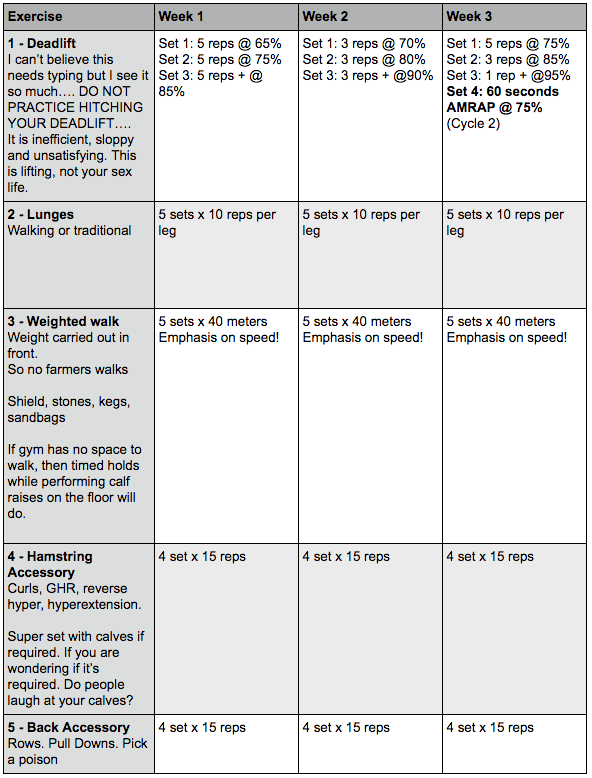
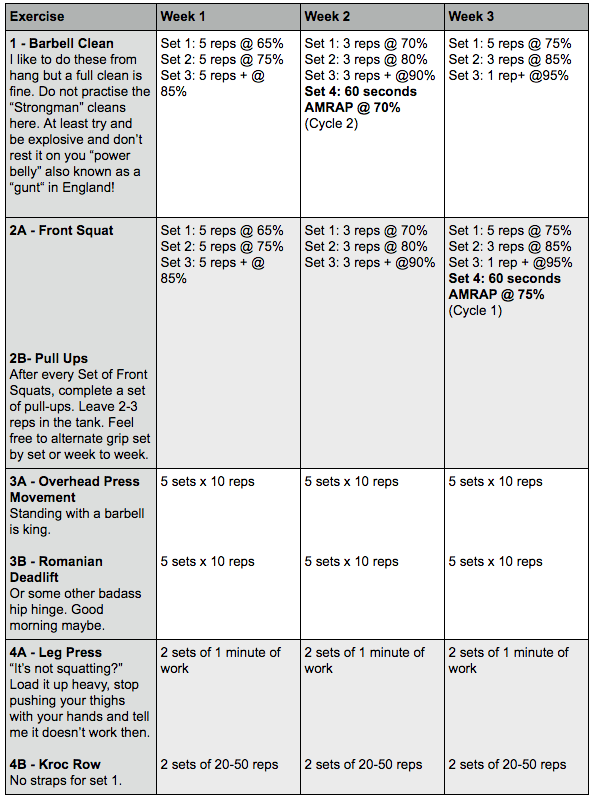
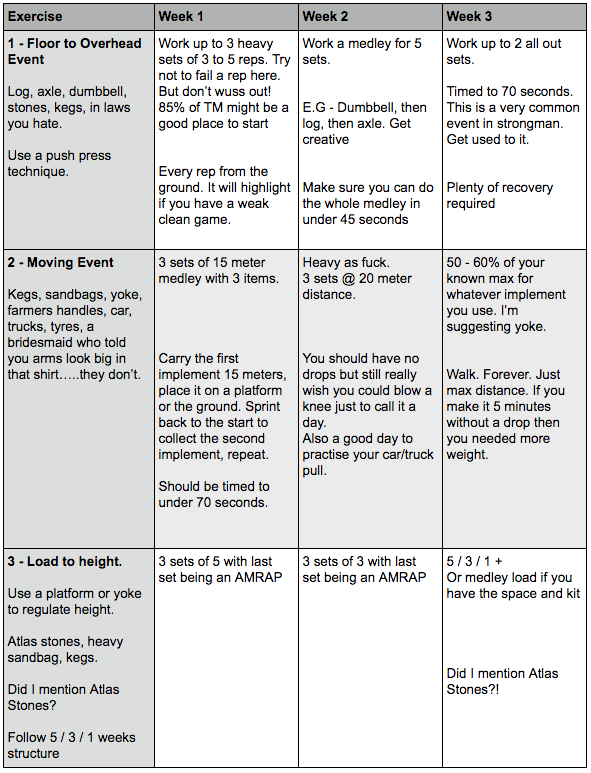
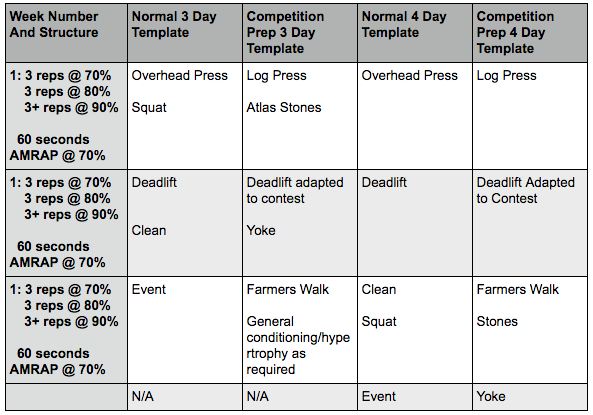
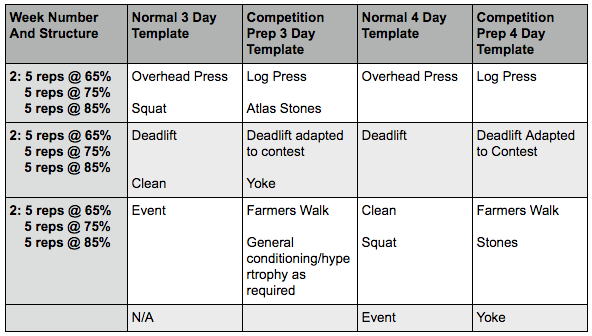
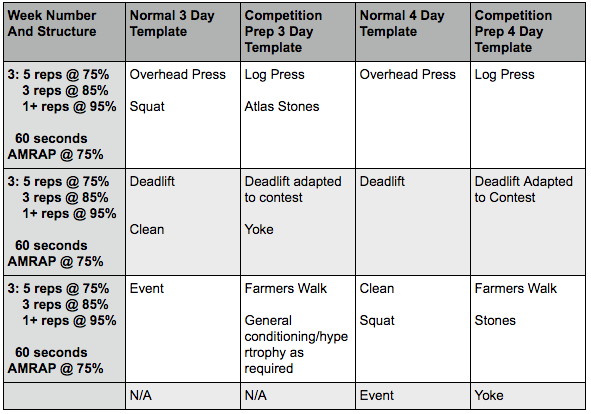
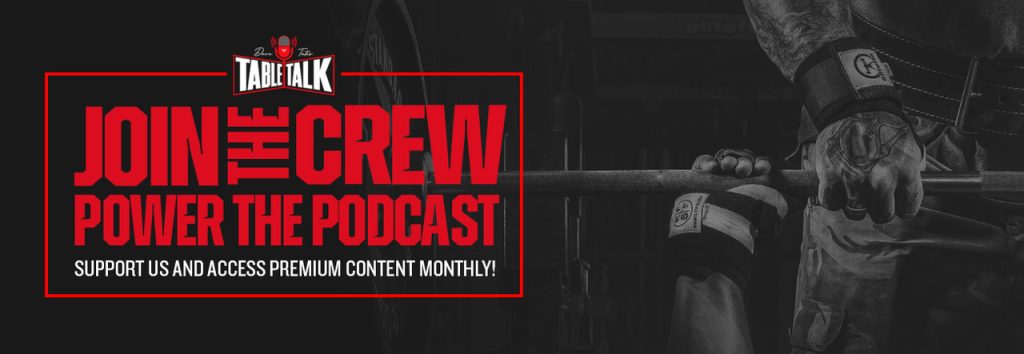
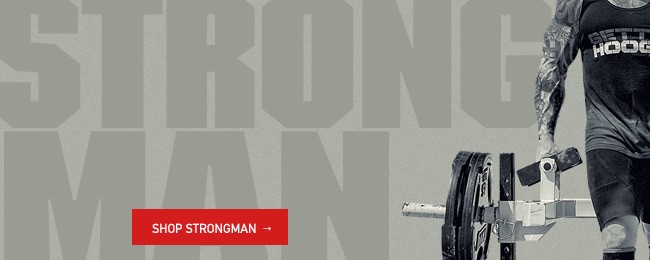
Well thought out, and laid out.
Vincere vel Mori
I’m just thrilled people are reading it at all! Otherwise it was just the written ramblings of some loon to read back to himself.
Thank you again, guys
Haha! To be honest I'm just glad people are reading it! Otherwise it was just some loon writing down his own ramblings to read back to himself.
Now if you could please explain the real meaning of 'gunt' to our American friends that would be great... ;-)
Errrr..... I'll leave that one up to Google as I'm willing to bet you get some truly haunting images :P
Personally I would still favour a strict press variation but there would be no harm in swapping it out for a push press for a few cycles throughout the year :)
Thanks for reading, dude
Glad you liked it.
Please feel free to send me some feedback after a few cycles to let me know what you think :)
I really liked your article. Thanks a lot. Free strongman programs aren't easy to find.
One question: Why the heavy emphasis on barbell cleans? I don't see a lot of strongman doing them and I am a little confused.
I'm glad you liked it and thanks for the question.
I've put a big influence on barbell cleans for two reasons.
Firstly, t's a common weakness I've seen at competitions. Guys who can press a lot more weight overhead than they can get to their shoulders. Or they run out of steam very quickly if the event is a floor to overhead every rep rather than one clean then reps from shoulders.
Secondly it is (in my opinion at least) more energy efficient to clean the bar straight up rather than the more common "continental cleans" we see a lot in strongman (resting the bar on the belly or belt at the mid point of the lift) Plus I've attended a few under105kg events recently where we have not been allowed to rest the bar on our belt, so have had to clean the bar.
I think if an athletes clean is already up to scratch with their press then you could definitely replace the higher rep cleans with another supplemental movement to address a weak point but I would personally keep it in as a 5/3/1 movement to ensure it never falls too far behind the press strength.
Also, cleans are a bitch to do high rep so free conditioning :P
Hope that answers your question, dude.
I feel Strong Woman is just starting to get started as a popular sport--very excited to be a part of it and this article was SUPER helpful. I also loved your Atlas Stone article.
Thank you
With the leg press I would look to replace it with goblet squats. Nice and simple to do with no spinal loading. Hope this helps. Let me know if it works for you
Isolated AB training, not something you do/feel the need for?
Thanks for a great article.
Christian, apologies for the delayed response. I prescribe ab work if it's a weakness of the individual so 9 times out of 10, Hell yes! Glad you liked the article .
Sarah.
Great to see the female side of this sport getting bigger and bigger. You're going to love the training.
If either of you have any queries feel free to fire them over to me or find me on IG @i.a_m.strong
I've seen a lot of people say 5/3/1 doesn't have enough volume to stimulate growth. Do you think the 3 sets are enough for this program, or could someone add the "first set last" variant or joker sets?
Thank you
Just recently found this program and after doing a months worth of it, it has proven to be perfect to reflect on my current job for carryover. Now I’d like to ask about your personal recommendations for supplements such as creatine or anything you find to be a must. Thank you for your time.
Thank you for the review and feedback..
I must admit I’ve never seen that program but now I have some morning reading to do
I tend to use power cleans for strongmen rather than squat cleans. I’ve found we aren’t always the most mobile bunch and the power clean has nice crossover to the log and belt clean with overhead events. Hope this helps
For the front carry on day 2 I do front rack yoke walks with weight near my 1rm FS. Tryna build more comfort in that position. Finding this works well.
Whats the purpose of the 3-5 minute yoke walk? I can appreciate the reasoning for every other movement but I am stumped on this one
In the base program the conditioning is partly covered by the 60 second AMRAP sets and the weighted walks.
If I was adding extra conditioning I'd do it on the off days. 20 minute sessions using 45-60 seconds of work with 3-5 minutes of rest.
Hope that helps :)
The extended periods on the yoke are just mental fortitude and muscular endurance. The program would also work with shorter walks on a heavier percentage if you'd prefer to take that approach. Just take into account the extra weight of the spinal loading if going heavier :)
Just about to wrap up my second cycle on this so far (using 3 weeks on, 1 off. I'm an old man and need recovery haha).
Here is a problem I'm finding:
I'm really tall and have super long arms. Think Hafthor height, but half his weight. And I'm not strong enough yet to pull 18" stones, though I am close. My arms, thus, either have to wrap around the smaller diameter stones several times on the load like I'm hugging them, or they are at 9 and 3 (instead of 10 and 2). Both of which are putting some stress on my bicep tendons.
What do you suggest? Give up stone training and focus on other exercises to help with me getting to the 18 diameter stones? Practice the one motion stone, which takes out a lot the lapping and hugging part I'm having a problem with?
Thanks :)
Haha! Well I hear recovery is very important!
The stones are tricky. First up, with hand position I find 10 and 2 works very well when using tacky but 9 and 3 is preferable for no tack. Sounds like you may have a gripping issue. We do rows with the atlas stones to help our grip on them. Think bent over barbell but you know, with a stone. Make sure your forearms are doing the gripping. Try and push your wrists and elbows together to get as much surface area on the stone as possible. If you wish to find me on IG. a.l.moody send me a couple clips of you lifting stones and I’ll take a look
Yes, the idea is to get it all in.
Where you see an A and B exercise this indicates a superset. If your fitness is on par with mine you’ll want an oxygen tank nearby
Thanks for the question.
Yes I’m a big believer in exercise rotation. Conjugate, baby!
Putting in sumo cycles would be a fantastic way to avoid accommodation and work some muscle groups that don’t get as much attention in the conventional pull
Thanks for the question. I’ve got a couple of guys who substitute the bench press in place of the clean as the main lift. Then just make sure they clean their overhead work rather than take it out of the rack.
The original program only highlights the jumps for the main working sets but I would also look to progress in the accessory work too.
The jumps might be a little less consistent across all accessory work so it might even take some session by session tweaking to find a sweet spot.
With regards to the accessory work you can also manipulate the rep schemes for some cycles if your hitting roadblocks on just putting the weights up.
Hope this helps :) Feel free to message me on IG @a.l.moody if you need more help
Thanks for the program this is exactly what I was looking for. I have a competition in about 8 weeks and was going to try and run this template to train for it. A few questions, it's a back and forth axle/log medley how would you implement both of those and what variation would you find best for car deadlift training for reps? Thanks for any help!
If you have access to the axle/log then I'd set up in contest style and work to a 5/3/1 rep range. Try to make sure you're comfortable with the two different styles of clean for those implements.
As for the car deadlift if it's side handles then move over to a trap bar (if you have one) but I wouldn't change my training hugely for car deadlift vs regular deadlift. There are some differences on the day but mostly technical. A strong deadlift will still score you well on the car deadlift.
Hope this helps. If you need anything else please feel free to DM me on IG.
@hereford.strength.coach